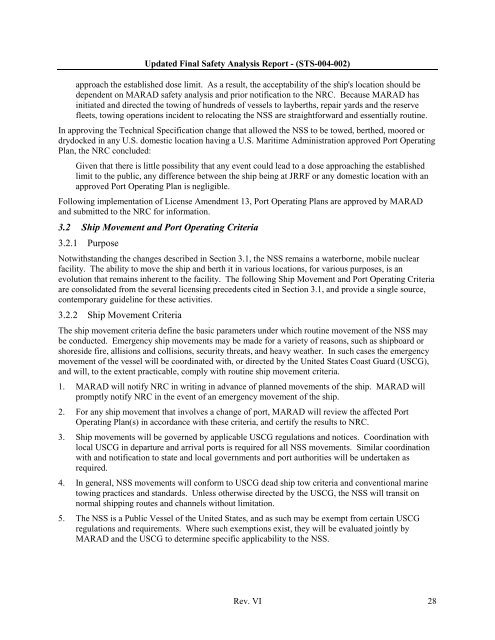10 CFR 50.71(e) - Maritime Administration - U.S. Department of ...
10 CFR 50.71(e) - Maritime Administration - U.S. Department of ...
10 CFR 50.71(e) - Maritime Administration - U.S. Department of ...
Create successful ePaper yourself
Turn your PDF publications into a flip-book with our unique Google optimized e-Paper software.
Updated Final Safety Analysis Report - (STS-004-002)approach the established dose limit. As a result, the acceptability <strong>of</strong> the ship's location should bedependent on MARAD safety analysis and prior notification to the NRC. Because MARAD hasinitiated and directed the towing <strong>of</strong> hundreds <strong>of</strong> vessels to layberths, repair yards and the reservefleets, towing operations incident to relocating the NSS are straightforward and essentially routine.In approving the Technical Specification change that allowed the NSS to be towed, berthed, moored ordrydocked in any U.S. domestic location having a U.S. <strong>Maritime</strong> <strong>Administration</strong> approved Port OperatingPlan, the NRC concluded:Given that there is little possibility that any event could lead to a dose approaching the establishedlimit to the public, any difference between the ship being at JRRF or any domestic location with anapproved Port Operating Plan is negligible.Following implementation <strong>of</strong> License Amendment 13, Port Operating Plans are approved by MARADand submitted to the NRC for information.3.2 Ship Movement and Port Operating Criteria3.2.1 PurposeNotwithstanding the changes described in Section 3.1, the NSS remains a waterborne, mobile nuclearfacility. The ability to move the ship and berth it in various locations, for various purposes, is anevolution that remains inherent to the facility. The following Ship Movement and Port Operating Criteriaare consolidated from the several licensing precedents cited in Section 3.1, and provide a single source,contemporary guideline for these activities.3.2.2 Ship Movement CriteriaThe ship movement criteria define the basic parameters under which routine movement <strong>of</strong> the NSS maybe conducted. Emergency ship movements may be made for a variety <strong>of</strong> reasons, such as shipboard orshoreside fire, allisions and collisions, security threats, and heavy weather. In such cases the emergencymovement <strong>of</strong> the vessel will be coordinated with, or directed by the United States Coast Guard (USCG),and will, to the extent practicable, comply with routine ship movement criteria.1. MARAD will notify NRC in writing in advance <strong>of</strong> planned movements <strong>of</strong> the ship. MARAD willpromptly notify NRC in the event <strong>of</strong> an emergency movement <strong>of</strong> the ship.2. For any ship movement that involves a change <strong>of</strong> port, MARAD will review the affected PortOperating Plan(s) in accordance with these criteria, and certify the results to NRC.3. Ship movements will be governed by applicable USCG regulations and notices. Coordination withlocal USCG in departure and arrival ports is required for all NSS movements. Similar coordinationwith and notification to state and local governments and port authorities will be undertaken asrequired.4. In general, NSS movements will conform to USCG dead ship tow criteria and conventional marinetowing practices and standards. Unless otherwise directed by the USCG, the NSS will transit onnormal shipping routes and channels without limitation.5. The NSS is a Public Vessel <strong>of</strong> the United States, and as such may be exempt from certain USCGregulations and requirements. Where such exemptions exist, they will be evaluated jointly byMARAD and the USCG to determine specific applicability to the NSS.Rev. VI 28
















